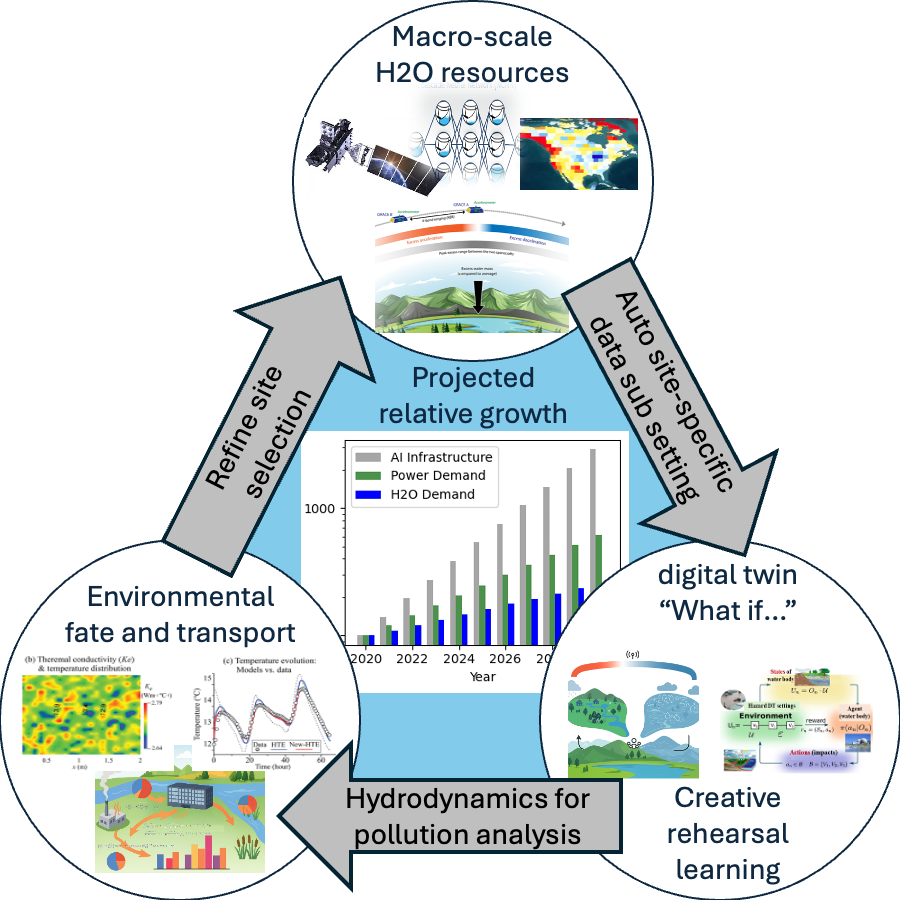Doing AI Hydrology to assess water resources for AI expansion... to continue doing AI Hydrology
In January (2025), the Stargate project was announced by the president of the United States, which will be a $500 billion investment over the next four years building new AI infrastructure.
In 1956, we introduced the National Interstate and Defense Highways Act (NIDHA) with an authorization of $25 billion (equivalent to $215 billion in 2024). The typical take on the NIDHA is that it facilitated an economic growth, national security and personal mobility. Another take, however, is that the highways destroyed American cities, segregated economic classes, and created a mobility barrier requiring a personal automobile. There is no doubt, what-so-ever, that the NIDHA changed American life and culture (for better or for worse...). Shortly after the NIDHA the air quality in Los Angeles reached an all time low, before the Clean Air Act in 1963 set a course for air quality improvement. Along with the Clean Water Act and the Endangered Species Act, these regulations are largely responsible for any protections we have against corporate pillaging of the environment.
Part of the Stargate project is a commitment from the federal government to eliminate any barriers to the expansion of AI Infrastructure. Presumably, this means no need for environmental regulation, nor consideration of the impact to American lives or culture.
Expanding AI Infrastructure will require increasing H2O demand, consumptive use, and pollution discharge, even with environmental regulation in place. The hydrological sciences now are thoroughly imbedded with AI Research. Common "low hanging fruit" papers are simply just slight modification of Deep Learning architectures, to keep up with the latest advancements from computer science, and adding a line on a standard benchmarking dataset. This is not by accident, but was actually called for by early adopters of the third book of AI in hydrology (including me).
Use of AI tools, like LLMs, is rapidly on the rise. From a H20 standpoint, this fact is itself troublesome. Even though I find these tools incredibly useful for my daily tasks, particularly programming, I am now beginning to reflect on the importance of my task in general. I've been writing computer programs for hydrology and hydraulics modeling since 2008. Sometimes these models are considered "AI", sometimes they aren't, but recently almost all my models incorporate some aspect of AI. My whole academic career has been defined by my development and analysis of AI for hydrologic and hydraulics modeling. You see, I've been riding this growing wave of research funding specifically for AI for H&H modeling. We are now at a point where hydro research without AI has little chance of funding. And I suspect this to be the case in most other academic fields as well. The feeling I am getting is "Do AI, or we aren't going to fund your research".
Recently though, I've heard several anecdotes of businesses now taking the same stance. Startup companies that don't have much AI tech involved probably aren't going to get funded. Just yesterday I heard that one company that had a long standing client in MS, but didn't have an AI portfolio, was told by MS to "start doing AI, or stop working with us." This goes well beyond a growth of a technology due to an organic increasing demand, and is starting to seem like growth for its own sake, perhaps as a means to keep the "bubble" growing.
I've spend my entire life advocating for means of transportation other than personal automobiles. I didn't know why, I just liked walking, biking and skateboarding over sitting in a car. In my late teenage years, I figured out that I really enjoyed small streets, vs large streets, but didn't know why. I stumbled upon a blog/group call Strongtowns some point in my early 20s, and I figured out the why. Small streets feel more comfortable because they are designed at the "human scale", while large streets with high speed limits are uncomfortable because they are designed for automobiles which need more space, particularly when traveling at high speeds. From Strongtowns, I also learned about the Automobile Infrastructure Growth Ponzi Scheme. In short, we continue to develop new roads, and we neglect to maintain the roads we have. It is growth for its own sake, not for the benefit of travelers. In most cases, I would actually argue (feel free to ask me about this later), that expanding road networks actually inhibits travel. Automobile infrastructure growth happens to take a whole lot of H&H modeling.
I've now found myself in a scenario where I'll be using and developing AI-based hydrologic modeling in order to evaluate and plan for increasing H20 resources for AI expanding infrastructure. What a time to be alive!

Note: This blog was written without the use of LLMs. Google was used sparingly.
